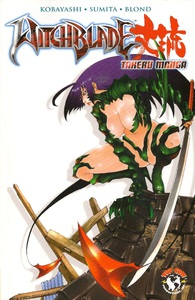Review
by Casey Brienza,Witchblade: Takeru Manga
GN
| Synopsis: |  |
||
Seventeen year old Takeru has been raised in a Buddhist monastery by her grandmother since the death of her parents many years ago. All seems normal enough in her small hometown…until demons appear and she is forced to bond with the Witchblade. To everyone's horror, Takeru starts to lose her grip on humanity and discovers that she is half-demon herself. Not even the U.S. government, which has apparently been responsible for engineering this tragedy in the first place, can rein in her thirst for blood. Takeru singlehandedly destroys all the demons and an American naval fleet in revenge. Her friend Kou, descended from the town's legendary demon hunters, is ultimately forced to amputate Takeru's arm—and the Witchblade with it—to stop her rampage for good. |
|||
| Review: | |||
The English language adaptation of writer Yasuko Kobayashi (also involved in the creation of the Witchblade anime) and artist Kazasa Sumita's Witchblade: Takeru Manga comes in two graphic novel editions: 1) a two-volume, 5x7 inch black and white edition that reads in the original right to left format from Bandai Entertainment, and 2) a single-volume, 6.5x10 inch full-color edition that reads left to right from Top Cow. The ostensible objective to this multi-release strategy was to appeal to both manga and American comics readers with formats familiar to each, but this review will be focusing specifically upon the Top Cow edition. In fact, unless you are a die-hard purist who blows a gasket at the mere thought of a manga that has been flipped and colored, I would recommend that potential buyers considering one edition or the other purchase the Top Cow edition in lieu of the Bandai ones. Both will set you back approximately twenty bucks in total, but the former boasts a larger trim size, better paper quality, and a large number of attractive, exclusive pin-ups by Kazasa Sumita and other guests artists such as David Mack (of Kabuki orientalist fantasy fame). Besides, as the afterword written by Sumita reveals, it is clear that this manga was intended right from the beginning to be published in the United States as well as Japan. And as such, a future American audience was taken into consideration during its creation. This means that even though much of it was drawn from the crotch-level perspective of an eromanga, there is no overtly sexual content. (Too bad, really, given Sumita's experience with adults-only material.) Likewise, Takeru's enormous, gravity defying breasts and equally enormous, powerful thighs look are very much in the spirit of the original Witchblade. Yet it is exceedingly difficult to tell that any particular stylistic accommodations were made solely from the Japanese editions, so the fact that bigger pages and the addition of color alone make the series look virtually indistinguishable from its many American counterparts is absolutely amazing. Truly, comics are become an international medium with international standards of stylistic and narrative practice. The only things left to immediately “betray” its origins are the vertically-biased text bubbles. But while the multi-national presentation is fascinating and Sumita's artwork luscious, nothing else about Witchblade: Takeru Manga is exceptional by comparison. The characters are one-dimensional plot vehicles. Takeru is either shy or sexy; Kou is always shy and steadfast. The grandmother is benevolent; the girlfriend is mischievous. The demons aren't all bad; the U.S. government proves to be bad to the bone. And so forth. Even Takeru's wholesale destruction of the American fleet after they firebomb her hometown reads just like yet another post-World War II revenge fantasy that (mis)casts the Japanese as helpless, hapless victims of a war that they have conveniently forgotten that they started in the first place. This accusatory theme seems a bit petulant, given that Kobayashi knew that Americans would soon be reading the story. Otherwise, everything else here is standard manga fare, though perhaps American comics readers with little manga experience might find it novel and intriguing. All in all, the manga seems to slot in well with the rest of Witchblade's expansive franchise, including the Japanese anime and novel series. For example, though the way in which the so-called “Demon's Claw” seems to be turning Takeru into a demon herself is a bit disconcerting for those familiar with the American comic since that has not heretofore been one of the Witchblade's properties, this oddity is soon explained and resolved as a misconception. Completists will definitely want to pick this one up, irrespective of its many narrative flaws. Those unfamiliar with the franchise may do so as well without many comprehension difficulties, though why they would want to remains an open question. |
| Grade: | |||
|
Overall : C+
Story : C
Art : B
+ Attractive eromanga-esque art and character designs that safely stops short of the genuinely erotic. |
|||
| discuss this in the forum (4 posts) | | |||
| Production Info: | ||
|
Full encyclopedia details about Release information about |
||